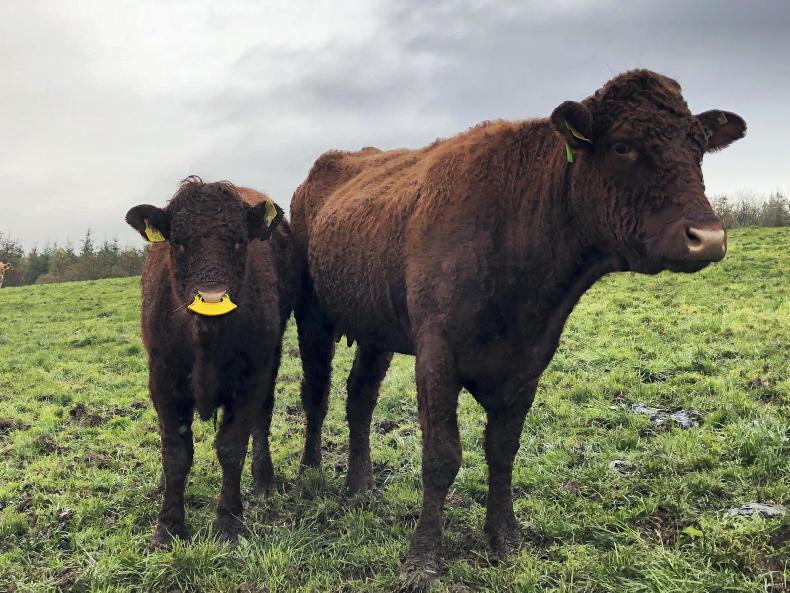In animals, the natural ‘fight or flight’ response allows them to escape from predators and survive in the wild. With domestication cattle have become more docile and this response is not as pronounced.
However, cattle experiencing physical or environmental discomfort over a period of time will have a natural physiological reaction – stress.
Stress has lots of consequences, but at weaning it lowers immunity, or the ability of the animal to fight infection.
Optimal production is about weight gain and health. To be healthy animals need an active immune system to fight infection.
So these top tips coming up to weaning will ensure we maximise immunity and minimise stress.
1. Gradual weaning
Abrupt weaning can be stressful, so farmers have found that removing smaller batches of cows over a five to seven-day period helps.
A minimum of five days must pass between each group that leaves the field. Some farmers find nose flaps useful to help restrict suckling and begin to break the bond.
Raising the electric fence to allow calves to creep forward for the month leading up to weaning can also help reduce stress, and provides good grass for the young, developing rumen.
2. Feeding meal
Smooth rumen transition is one of the key factors in weaning and feeding meal helps to achieve this. You must begin meal feeding at least one month before weaning.
Start with small amounts of highly palatable, low-protein, high-energy ration.
Gradually increase this each week, with the aim is to have them eating 1kg of meal or greater at the time of weaning.
Avoid dusty meals or forages indoors, as they can irritate the airways.
There is no better investment than meal. It helps to reduce the cost of weaning and, more importantly, allows the rumen of these young calves to develop.
Remember, any time you change the diet it takes the rumen two weeks to adjust.
3. Water
This is a basic but key ingredient for your weanlings, whether inside or out.
Their rumen needs water to balance out the extra meal intake and for the maintenance of a healthy immune system.
4. Maximise immunity
Vaccines stimulate the immune system; they are created to cover specific agents or pathogens. So certain vaccines are designed to protect against certain diseases.
The main challenge around weaning time is pneumonia, so respiratory vaccines are the ones we get the best results with.
You always get a better result from a vaccine when you give it to a healthy animal before the challenge arrives.
Some really good protocols include IBR, RSV, PI3 and some bacterial cover as well.
While vaccines may seem expensive, dead animals and lost performance are a much bigger cost.
Some farmers will choose to use both intranasal IBR and RSV PI3 before weaning and this can work, but it gives only 12 weeks of cover.
I prefer a vaccination strategy that includes all the viruses but also provides bacterial cover for the weaning period, the stressful time of housing and perhaps sale time.

5. Parasites
With abundant grass, calves are at risk of worm burdens, particularly on highly stocked platforms with previous history of worms.
The main offenders are roundworms or stomach worms. From mid-August onwards watch out for coughing in weanlings and don’t ignore it.
If you are treating for lungworm burdens delay weaning until at least 10 days after dosing, to allow the lungs to recover.
Do I dose healthy animals before weaning? This is a good question and some farms will carry out a faecal egg count test on six to eight calves to check for eggs.
If there’s no coughing, weight gain is good and no FECS greater than 100epg (done two to three week before weaning), then dosing might not be a priority.
For calves with scour, we must also consider rumen fluke and, less commonly, coccidosis.
Again, only wean healthy animals, with dry manure, and faecal samples to guide you in a diagnosis.
Depending on how close weaning is to housing, that may change your dosing strategy.
6. Monitor calves twice daily
No matter what your management strategy is, it’s absolutely key to walk through weanlings and cows twice daily for the first two weeks after weaning.
Most diseases, particularly respiratory viruses, will have an incubation period.
Once a smooth transition has been made, after two weeks the risk is massively reduced.
7. Pneumonia management
Close monitoring of calves and a good treatment plan that uses a long-acting antibiotic or an anti-inflammatory is key.
Have a thermometer on hand to check temperatures and act when they go over 39.5°C, along with other signs.
If housing at weaning time, give them much more space for the first two weeks, plenty of fresh water and clean out meal troughs daily.
Avoid dusty meal and bedding for the first 10 days as this irritates the airways.
Maximise fresh air on days with poor wind – I rarely ever block up sheds where pneumonia was an issue in weanlings.
Clip their backs from their neck to their tail head, about 30cm across, before housing.
8. Castration or other stressors
Castration causes pain for a few days as well as stress.
Any calves should NOT be castrated near weaning and get veterinarian involvement to provide pain relief afterwards.
9. Grass tetany
Keep a close eye on your cows after weaning as the stress can often bring on grass tetany because of low intakes.
Have high-magnesium licks or dust small amounts of meal with sweetened calmag available to animals for the two weeks after weaning.
10. Transport
If you’re transporting calves at weaning time do it slowly and quietly. Have your trailer set up and well bedded.
Open all vents to allow maximum ventilation and always put in one less than capacity to maximise lying space during transport.
Drive easy to minimise stress and maximise safety.






 This is a subscriber-only article
This is a subscriber-only article










SHARING OPTIONS: